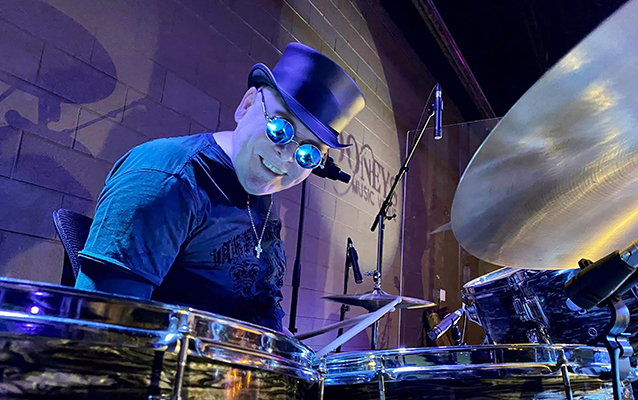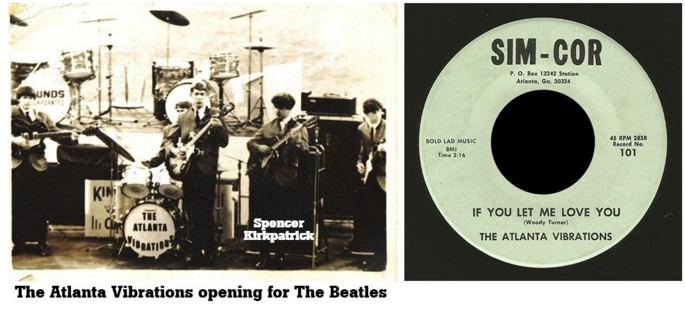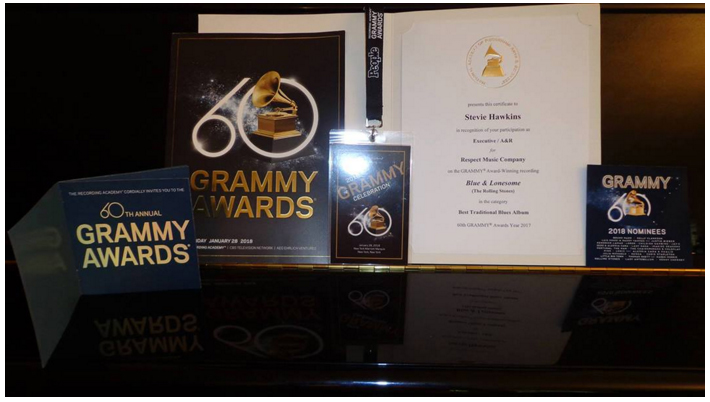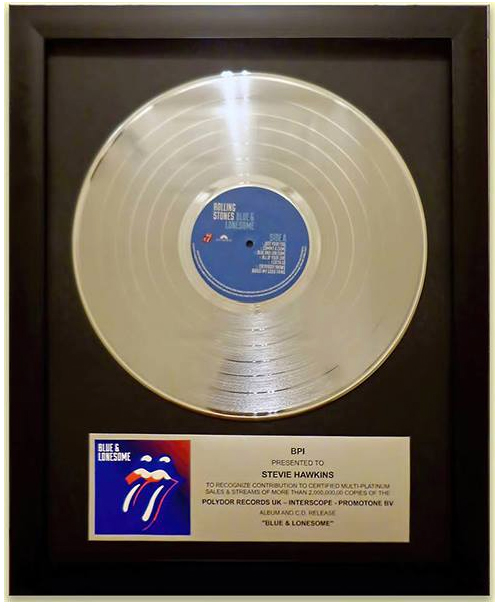

| HOME | ABOUT |
 |
| Stevie Hawkins |
An Interview STEVIE HAWKINS & THE LEVITATING TOADS Interview with the person behind the writing and production of Stevie Hawkins & The Levitating Toads By Ozzi Roth - AMG ~ Hollywood Report After being more than 40 years in the music business already, musicians of Stevie Hawkins & The Levitating Toads have a very impressive resume to show for it. Individually, they have toured across America, Canada, Europe and Asia, and now have released a catchy single called "You Are My Life.” During a recent trip to Atlanta, I had the chance to talk with Stevie Hawkins (vocals, drums, producer, engineer and writer of the song) about the project, so here we go. |
What genre of music do you consider your work to be? Who are your major influences? Genre? I suppose this particular song could be considered or classified as 1960s or 1970s British Pop. Although in general, the stuff we have recorded together could probably be categorized as classic rock. Collectively, we are influenced by any music that is good.Is there a hidden meaning in or to any of your music? No, nothing in particular. Simply out there, it’s all about love!What is the origin of the band name? The Levitating Toads portion originated from an online band name generator. [laughs] I was having difficulty formulating an odd name relating to levitation, so I thought just for fun, I would try a band name generator. Entered the word "levitate" into the name generator, The Levitating Toads was one of the results, I liked that in its oddity, so here we are!Who are the band members? We aren't a band in true sense of definition. We could be considered a studio unit, but could easily and readily perform a show as a band if necessary. For "You Are My Life", Spencer Kirkpatrick plays the 12 string Rickenbacker, on the bass guitar is Jimmy Puckett, Jimmy Hill plays electric guitar, and myself performing the vocals, drums, synthesizers, Mellotron and percussion.How long have you known each other? How did you meet? We've know each other for at least 35 years. Spencer Kirkpatrick and I played together for about 12 years in a group called ‘The Ron Kimble Band’ in Atlanta beginning in 1984. We've also worked together on many studio recordings over the years.I met Jimmy Puckett in 1989, a short time before recording You Are My Life. As best I recall, Puckett was playing with Georgia Satellites guitarist Rick Richards, another guitarist and a drummer at a night club called the Copper Dollar Saloon located in Decatur, Georgia. The Copper Dollar was located about two blocks up-street from a night club where Spencer and I played called, Hemingway's. I dropped into the Copper Dollar one night on my way home from the gig. When I walked in, the band was playing, and behind Jimmy on stage stood an Indian tee-pee of which Jimmy would walk in and out of while playing. Mind you, I didn't know Puckett or any of the other guys in the band. Watching Puckett perform was fun. When the band went on break, Jimmy went inside the tee-pee and kept peeping out of it with a mischievous grin. Then after several minutes, he comes out of the tee-pee and walks up to the microphone carrying a vending tray as would be used by a concession vendor at a sporting event. Over the microphone he said, "hot dogs for sale, hot dogs for sale. I'm trying to earn some extra money!" People were laughing, while others went up to the stage thinking it was a joke same as me, but he did in fact have hot dogs in the vending tray. He sold everyone of them. A guy this whacky, I just had to meet! Not to mention he was a stellar bassist and a perfect fit as a bassist for a few original tunes I happen to be formulating at that time. I met guitarist Jimmy Hill through Jimmy Puckett, also in 1989. Puckett brought Hill to a few recording sessions where Hill tracked guitar on two or three songs. Have you toured together at any point, or is there any other background about the guys you could share with us? Spencer, Jimmy Puckett and myself have toured with major label artists and performed in concert arenas, but not together as a band. To be honest, I am uncertain of Jimmy Hill’s background. He remains an enigma in that regard.Spencer Kirkpatrick has bragging rights not many have. At age 14, his band, The Atlanta Vibrations, won a local Battle of The Bands contest sponsored by a local Thomas Organ music store, for the opportunity to open for The Beatles, at Fulton County Stadium in Atlanta, Georgia on August 18, 1965. Band members included Woody Turner – lead vocals, guitar, Spencer Kirkpatrick – guitar, Bob Giannoni – bass, Charles Lunsford – guitar, Ricky Wafford – drums. Major label opening acts for at this concert included soul sax player King Curtis, and Cannibal & The Headhunters. However, unbeknownst to Beatles manager Brian Epstein, the local concert promoter also had added The Atlanta Vibrations to the bill. The Vibrations showed up early at the stadium, proudly wearing their collarless jackets and hauling in their Vox Super Beatle amps, provided by a music store. Epstein told them to leave. Then, fate intervened. John Lennon’s Vox organ was somehow damaged during the trip from Toronto, and there was only one other Vox organ in the city of Atlanta. It was at Thomas Organ. The Vibrations sent a runner up to the Buckhead music shop to fetch back a working instrument. Lennon used the borrowed Vox organ and Epstein let the Vibrations open the show. The Vibrations set included “Pipeline” and “Walk Don’t Run” by The Ventures, and an instrumental version of The Beatles tune “This Boy.” The Atlanta Vibrations also released a 45 single titled "If You Let Me Love You" and "My Hometown" in 1965 on Sim-Cor, a local Atlanta label.  I suppose Spencer is best known as lead guitarist and co-writer for the 1970s rock group, Hydra with Wayne Bruce, Orville Davis, and Steve Pace. Hydra released two albums on Capricorn Records distributed by Atlantic/ATCO Records. In 1974: “Hydra” and 1975 “Land of Money.” Their third album “Rock The World” was released on Polydor Records in 1977. In 2005, I recorded and produced Hydra’s forth album, “Live-After All The Years,” released on Emphasis Records. Spencer has toured extensively sharing the stage with Lynyrd Skynyrd, ZZ Top, Blue Oyster Cult, Wet Willie, Marshall Tucker, Kentucky Head Hunters, Charlie Daniels Band, Trapeze, Eric Quincy Tate, I could go on and on.  While in the above mentioned Ron Kimble Band, Spencer and I performed together playing for soul legend Percy Sledge, and Bertie Higgins “Key Largo” song fame from the 1980s. We also opened for The Marshall Tucker Band, Jerry Jeff Walker and The Coasters. Jimmy Puckett toured and performed concerts playing bass for renowned blues guitarist, Tony Sarno. Jimmy has covered a lot of Atlanta rock scene bases over the years. Some of the bands Jimmy toured with performing concerts are, Armon, Riff Raff, The Dunwoody Muthers, Jesse James Dupree (Jackyl), El Cee, and early incarnations of the Georgia Satellites. As for myself, I am a recipient in the 2017 60th Annual Recording Academy - Grammy Awards for contribution to The Rolling Stones “Blue and Lonesome” album, winner of the Grammy for “Best Traditional Blues Album.”  I also received a platinum plaque for contribution to The Rolling Stones “Blue & Lonesome” album.  I’ve released four solo singles, and three solo albums on Emphasis Records; “Georgia Jam”, “High Time” and “What The Funk?”. My 2012 album “What The Funk?” won three accolades at the Los Angeles Music Awards - Hollywood, for “Record of the Year”, “Urban Artist” and “Male Singer/Songwriter.” Since the mid 1970s, I have continually toured with many major label artists as a vocalist and drummer including Chuck Berry, John Lee Hooker, Albert King, Brook Benton, Percy Sledge, Leon Russell, Dan Seals, Gregg Allman, Johnny Winter, Daryle Singletary, Johnny Rodriguez, Jeff Carson, Cledus T. Judd, and others. Should someone want to know more, a general bio can be found on my website, http://www.steviehawkins.com/about.html  Who writes the songs for the band? I am the primary songwriter of the tunes Spencer, Jimmy & Jimmy and myself have recorded.How long did You Are My Life take to make from start to finish, recording-wise? Due to scheduling with the guys, the song needed to be recorded in four separate sessions. The first session was my creating a guide vocal track with keyboard and drum instrumentation. The second session was overdubbing Spencer Kirkpatrick's 12 string and 6 string guitar tracks. The third session was overdubbing Jimmy Puckett's bass part and Jimmy Hill's electric guitar. The fourth session was recording the strings, horns, percussion, Mellotron, and final vocal tracks, where I double, triple, and sometimes, quadruple tracked my voice. So, probably about 5 days in total to finish the recording.Are there any crazy behind the scenes anecdotes from these sessions that you can share with us? I recorded my drum and vocal tracks in the nude! Ha-ha! Just joking there!!! Nothing crazy, but yeah, a couple of memorable anecdotes to me. After inviting Spencer Kirkpatrick to the session, and explaining the Beatles type of British Pop tune he would be performing on, he arrived at the session wearing a tie-dye Dashiki shirt and round John Lennon sunglasses.Bassist Jimmy Puckett brought to each session a can of sardines, soda crackers, and packets of mustard of which he called "mustard shots", and a banana flavored Moon Pie for dessert. In order for him to achieve the proper Zen and play his best, he said he had to ingest those particular food items, or he would not be able to play his bass. [laughs] The remainder would be the guys putting up with my overactive producer’s head of “maybe try this, let’s try that, play a glissando here, hold that note a beat and 3/8ths longer, try a slight trill there, how about this, how about that.” I could drive a person nuts from a producer’s point of view back those days. Didn’t go for perfection, went for a feel, dynamics and simply tried to pull the best out of the people that I worked with. Did the producer (you) use any (weird) experimental miking and/or recording techniques? Me as a producer and engineer have always tried different things for a "sound.” There are a few techniques I recall that were used for the sessions.The bass drum on the tunes we recorded is in fact, an old leather suitcase, miked with a Beyerdynamic M 500 N(C) hypercardioid ribbon microphone. I rigged a wood plank on the bottom of the suitcase for connecting the bass drum pedal and to help keep the suitcase stationary. The trick for me was finding the right size and more importantly, the right “age” of leather suitcase. The suitcase had to be genuine leather from the 1950s or 1960s to sound right. Found one that worked sufficiently at a Goodwill store. Used it also on a few funk and fusion tunes during late 1980s recording sessions. It had a unique thud, resonance and sound to it when recorded. Somewhere along the way, the suitcase bass drum concept caught on and folks began mounting drum heads to suitcases, porting holes on the front side, placing tom and/or cymbal mounts on the top edges, mounting legs on the sides, and even to the extent that suitcase bass drums were being manufactured and marketed by boutique drum companies, selling for as much as $1000.00. I think I missed out on a marketing opportunity.  Was the suitcase difficult to play verses a real kick drum? Kick drum? Blasphemy! I don’t know who started the term “kick drum,” but for some reason I become irritated when the term is used. If a person “kicked” the drum, I could understand, but it isn’t “kicked,” it is played with a pedal, or a mallet, a stick, or sometimes with a hand. A bass drum is a bass drum, unless maybe you are Keith Moon and kick your bass drums off the riser! Okay, now that that is off my chest!I shall be mindful not to use of the term, kick drum (at least in your presence)! Glad we’re on the same page now. [laughs] To answer your question about playing the kick-case, I mean suitcase [laughs], it did take a wee bit of getting use to, because it was not as responsive a real drum. But I ultimately overcame that obstacle by adjusting the pedal’s spring tension along with using a wooden beater instead of a felt beater adjusted to a certain height on a 1970s model Ludwig Ghost bass drum pedal. That pedal ended up being specifically used with the suitcase.I find it fascinating some of the tricks people have used over the decades when recording music. What other techniques did you use? For the 12 string electric guitar, I chose to use a vintage 1963 OAHU Publishing Company amplifier miked with a 1979 model Pearl DM-9000, combined with boundary or pressure zone miking. While Spencer played the guitar, I walked around the studio with my ear to the wall searching for a unique guitar tonality to layer with the amplifier microphone on a separate track. After finding a nice sounding boundary with the guitar sound reflecting from the wall, I placed a Shure SM57 microphone at that spot and the exact distance my ear caught the sound, which would be approximately 1/8th of an inch, and then recorded the guitar. I first witnessed a recording engineer using the “ear to the wall” boundary or pressure zone technique during a session at the Record Plant recording studio in New York during 1976. This was several years before the pressure zone microphone "PZM™" was introduced to recording studios, theaters, and audio market in general by Crown and Radio Shack.As a note, I remain the owner of the OAHU Publishing Company 5-watt amplifier used for the session, all original with 8 inch Jensen speaker, tubes and circuitry. My particular amp was manufactured for OAHU by Valco, and is an exact 1963 Supro model 1606 "Super". Gretsch also sold a version of the Valco amp in 1963, known as the model 6150. Also, the Pearl DM-9000 dynamic microphone used to mic the amp was made by Gibson / Norlin during the late 1970s. This is another example of an excellent Gibson product that was poorly marketed and short lived. The DM-9000 as well as the Pearl CM-5000 microphone are top of the line in sound, and I remain owner of the DM-9000 and several other Pearl microphones from that era. Matter of fact, the CM-5000 is the richest sounding tom microphone I have ever used. Typically equalization isn’t necessary when using the CM-5000 on toms if the toms are tuned appropriately. Another technique I recall was the usage of “Through-Zero Analog Tape Flanging” on the 12 string guitar and background vocals. This technique was developed by Les Paul and first utilized on his 1952 recording of “Mammy’s Boogie.” A person can hear this effect on tunes such as The Beatles “Tomorrow Never Knows” (1966), the two bridge sections of The Small Faces "Itchycoo Park" (1967), The Lemon Pipers “Green Tambourine” (1967), Doobie Brothers “Listen To The Music” (1972), Queen's “Keep Yourself Alive” guitar intro (1973), and "Killer Queen" (1974), Robin Trower “Bridge of Sighs” (1974), Electric Light Orchestra “Evil Woman” (1975), and many more. The effect can only be achieved by utilizing two or three analog tape machines. There are hardware effect units and plugins that somewhat emulate the effect, but they simply can't reproduce the sonic depth and warmth of the sound. There are varying techniques to achieve the effect. Here’s the way I achieve the Through-Zero Analog Tape Flanging effect; a) I bounced the guitar to one track of an analog two-track reel to reel master recorder b) Fed the guitar on the two-track back into a channel on the console then to a track on the multitrack machine c) Cued the original and bounced 12 string tracks to near exact playback d) Simultaneously pressed the play button on both the two track and multitrack e) Gently intermittently placed my index fingers on the capstan wheels of the tape machines to cause a gentle phasing effect. f) Now I repeat steps b through e, with the exception of, I cue the bounced track a few milliseconds before or after the multitrack. At this stage I have to experiment with the cue/starting position this third layered track. Depending upon where I start the third track plays an important roll in the sonic depth and strength of the chorus or flange. The process was the same for the background vocals, with the exception the background vocals were stereo tracks. Sounds like somewhat a lengthy process to achieve the effect, but actually isn't once you have done it a few times. There were probably other tricks or techniques used, but the pressure zone miking and tape flange effect I distinctly recall utilizing. Do you find recording to be a challenge that you enjoy? Yes, when working in a traditional analog studio. No, when working in a total digital environment or "In The Box" as per the terminology. The recording and mixing process takes much longer in the digital audio realm and for me is very sterile.Do you have a record label? Are you a member of any music organizations? Yes. I co-own the label, Emphasis Records, and am a member of BMI as a songwriter. As a music publisher, a performing rights society member of both Uncle Slim Music - ASCAP and Hannon Hawkins Music - BMI. My label and BMI company has a song in the 2021 Oscar winning Warner Bros. Pictures film, "Judas and the Black Messiah". I am moving more toward the film and television direction with my music catalogs.What's your ultimate direction for the band? Are you seeking fame and fortune? There isn't one for us. This song, along with the few others that are to follow were recorded without an intent of anything but the fun and challenge of making music together as friends. I've simply decided to release the music in the off chance someone might enjoy listening, rather than let it be a scenario of just another tape on a shelf collecting dust. If positive and interesting things should happen to evolve in the future, we will have a look at whatever that might be at that time. There are no expectations.How can fans-to-be gain access to your music? The band website URL is: http://thetoadpad.com People can preview audio and immediately gain access to streaming and purchase links. |
|
||||||